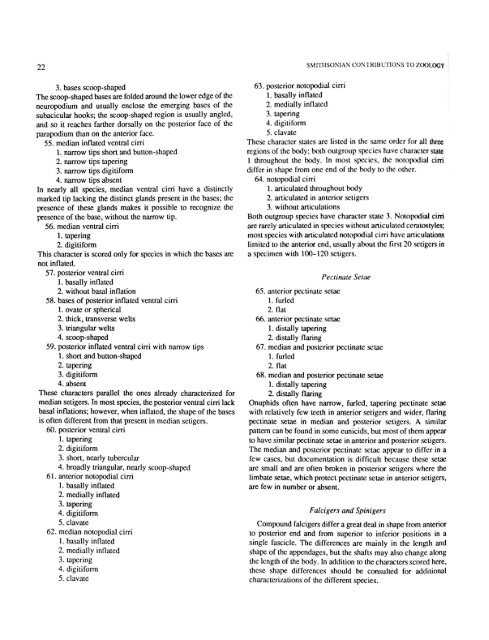A Review of the Genus Eunice - Smithsonian Institution Libraries
A Review of the Genus Eunice - Smithsonian Institution Libraries
A Review of the Genus Eunice - Smithsonian Institution Libraries
Create successful ePaper yourself
Turn your PDF publications into a flip-book with our unique Google optimized e-Paper software.
22 SMITHSONIAN CONTRIBUTIONS TO ZOOLOGY<br />
3. bases scoop-shaped<br />
The scoop-shaped bases are folded around <strong>the</strong> lower edge <strong>of</strong> <strong>the</strong><br />
neuropodium and usually enclose <strong>the</strong> emerging bases <strong>of</strong> <strong>the</strong><br />
subacicular hooks; <strong>the</strong> scoop-shaped region is usually angled,<br />
and so it reaches far<strong>the</strong>r dorsally on <strong>the</strong> posterior face <strong>of</strong> <strong>the</strong><br />
parapodium than on <strong>the</strong> anterior face.<br />
55. median inflated ventral cirri<br />
1. narrow tips short and button-shaped<br />
2. narrow tips tapering<br />
3. narrow tips digitiform<br />
4. narrow tips absent<br />
In nearly all species, median ventral cirri have a distinctly<br />
marked tip lacking <strong>the</strong> distinct glands present in <strong>the</strong> bases; <strong>the</strong><br />
presence <strong>of</strong> <strong>the</strong>se glands makes it possible to recognize <strong>the</strong><br />
presence <strong>of</strong> <strong>the</strong> base, without <strong>the</strong> narrow tip.<br />
56. median ventral cirri<br />
1. tapering<br />
2. digitiform<br />
This character is scored only for species in which <strong>the</strong> bases are<br />
not inflated.<br />
57. posterior ventral cirri<br />
1. basally inflated<br />
2. without basal inflation<br />
58. bases <strong>of</strong> posterior inflated ventral cirri<br />
1. ovate or spherical<br />
2. thick, transverse welts<br />
3. triangular welts<br />
4. scoop-shaped<br />
59. posterior inflated ventral cirri with narrow tips<br />
1. short and button-shaped<br />
2. tapering<br />
3. digitiform<br />
4. absent<br />
These characters parallel <strong>the</strong> ones already characterized for<br />
median setigers. In most species, <strong>the</strong> posterior ventral cirri lack<br />
basal inflations; however, when inflated, <strong>the</strong> shape <strong>of</strong> <strong>the</strong> bases<br />
is <strong>of</strong>ten different from that present in median setigers.<br />
60. posterior ventral cirri<br />
1. tapering<br />
2. digitiform<br />
3. short, nearly tubercular<br />
4. broadly triangular, nearly scoop-shaped<br />
61. anterior notopodial cirri<br />
1. basally inflated<br />
2. medially inflated<br />
3. tapering<br />
4. digitiform<br />
5. clavate<br />
62. median notopodial cirri<br />
1. basally inflated<br />
2. medially inflated<br />
3. tapering<br />
4. digitiform<br />
5. clavate<br />
63. posterior notopodial cirri<br />
1. basally inflated<br />
2. medially inflated<br />
3. tapering<br />
4. digitiform<br />
5. clavate<br />
These character states are listed in <strong>the</strong> same order for all three<br />
regions <strong>of</strong> <strong>the</strong> body; both outgroup species have character state<br />
1 throughout <strong>the</strong> body. In most species, <strong>the</strong> notopodial cirri<br />
differ in shape from one end <strong>of</strong> <strong>the</strong> body to <strong>the</strong> o<strong>the</strong>r.<br />
64. notopodial cirri<br />
1. articulated throughout body<br />
2. articulated in anterior setigers<br />
3. without articulations<br />
Both outgroup species have character state 3. Notopodial cirri<br />
are rarely articulated in species without articulated ccratostylcs;<br />
most species with articulated notopodial cirri have articulations<br />
limited to <strong>the</strong> anterior end, usually about <strong>the</strong> first 20 setigers in<br />
a specimen with 100-120 setigers.<br />
Pectinate Setae<br />
65. anterior pectinate setae<br />
1. furled<br />
2. flat<br />
66. anterior pectinate setae<br />
1. distally tapering<br />
2. distally flaring<br />
67. median and posterior pectinate setae<br />
1. furled<br />
2. flat<br />
68. median and posterior pectinate setae<br />
1. distally tapering<br />
2. distally flaring<br />
Onuphids <strong>of</strong>ten have narrow, furled, tapering pectinate setae<br />
with relatively few teeth in anterior setigers and wider, flaring<br />
pectinate setae in median and posterior setigers. A similar<br />
pattern can be found in some eunicids, but most <strong>of</strong> <strong>the</strong>m appear<br />
to have similar pectinate setae in anterior and posterior setigers.<br />
The median and posterior pectinate setae appear to differ in a<br />
few cases, but documentation is difficult because <strong>the</strong>se setae<br />
are small and are <strong>of</strong>ten broken in posterior setigers where <strong>the</strong><br />
limbate setae, which protect pectinate setae in anterior setigers,<br />
are few in number or absent.<br />
Falcigers and Spinigers<br />
Compound falcigers differ a great deal in shape from anterior<br />
to posterior end and from superior to inferior positions in a<br />
single fascicle. The differences are mainly in <strong>the</strong> length and<br />
shape <strong>of</strong> <strong>the</strong> appendages, but <strong>the</strong> shafts may also change along<br />
<strong>the</strong> length <strong>of</strong> <strong>the</strong> body. In addition to <strong>the</strong> characters scored here,<br />
<strong>the</strong>se shape differences should be consulted for additional<br />
characterizations <strong>of</strong> <strong>the</strong> different species.
















